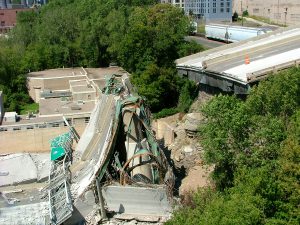Was Negligence Involved In The FIU Bridge Collapse?
 Michael Babboni
Personal Injury
When an accident occurs in a public space, such as a shopping mall, or even in a private space, such as the backyard and swimming pool of someone’s home, people always want answers. If an injury is involved, the most important question to answer will be “who is at fault? Is anyone at fault?” And right now, that is the question that police, engineers and other professional investigators are asking of the tragic bridge collapse that happened on March 15.
Michael Babboni
Personal Injury
When an accident occurs in a public space, such as a shopping mall, or even in a private space, such as the backyard and swimming pool of someone’s home, people always want answers. If an injury is involved, the most important question to answer will be “who is at fault? Is anyone at fault?” And right now, that is the question that police, engineers and other professional investigators are asking of the tragic bridge collapse that happened on March 15.The bridge, still under construction and closed to the public for at least another year, fell apart, of its own accord, crushing vehicles that were still allowed to drive underneath it. The accident took the lives of several people, including motorists driving under the bridge as well as staff onsite. There was no earthquake, no storm, no fire, no other outside causes that could have contributed to a sudden, catastrophic, structural failure, so what happened?
The Pursuit Of Fault
This is where forensic engineers will be critical to the investigation. Clearly something went wrong, some error occurred somewhere down the line as many structures are built all over Florida and the rest of the United States without this kind of collapse occurring. So the first task for the investigators will be to determine exactly where and why the bridge collapsed while it was being constructed.
This is the critical first phase of investigation because, as with a murder investigation, you can’t start assigning motive and suspects until you understand method. It’s not enough in this case to say “the bridge collapsed” because there can be any number of causes for why the collapse occurred, and each cause has a different source.
For example, if, hypothetically, it is determined that the bridge collapsed because material analysis reveals the inherent composition of the bridge components was poorly constructed, then the flaw may lie with the accelerated bridge construction process. This is a newer method of construction where individual components are built at other sites and brought to the actual site of construction and assembled like giant puzzle pieces. If that’s the case, then the negligence may lie in the composition process.
However, if, hypothetically, the cause is discovered to be the stress testing that was done to the components while being assembled, then fault would lie with whomever it was that either ordered the stress testing done in a neglectful manner, or the people onsite who were negligent in their duties while executing the stress test.
Whatever the case is, it will take time for experts and investigators to come to a final determination. However, the tragic reality of the FIU bridge collapse is that while it is undoubtedly an accident, and a tragedy, this was not random, nor was it unpreventable. Someone, somewhere, failed in some duty or responsibility, and the proof is that we don’t have other buildings or structures regularly collapse in the middle of construction. When the time comes, and truth is known the full extent—and nature—of the negligence exercised during the FIU bridge construction will become known.
